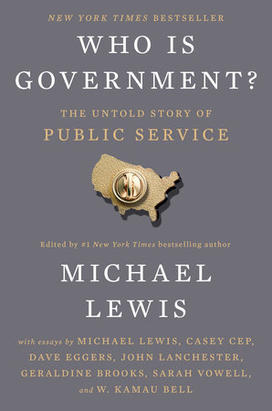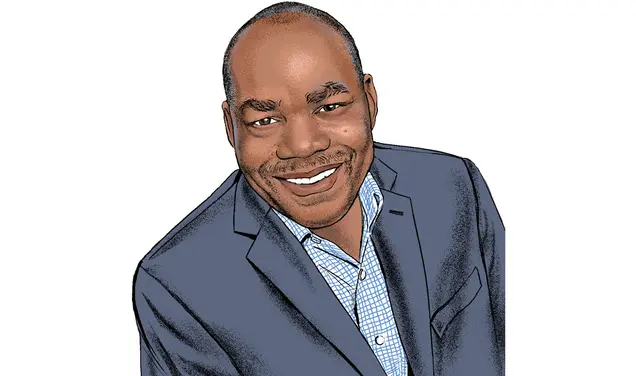Michael Lewis ’82 and Friends Highlight Contributions of Federal Workers in New Book
As Elon Musk wields his metaphorical chainsaw to systemically gut the federal government and enact mass layoffs in the federal workforce, one Princeton alum is touring the country to spread awareness about who these workers truly are — and the consequences of their firings.

Michael Lewis ’82, of The Big Short and Moneyball fame, edited a newly published volume titled Who Is Government? The Untold Story of Public Service. Lewis invited six of his favorite authors to find and lift up one person who was doing interesting work in the federal government.
Two of the authors, Casey Cep and Dave Eggers, joined Lewis on campus April 4 as part of a cross-country book tour. The panel, which drew a full house at McCosh 50, was moderated by Razia Iqbal, a visiting professor at the Princeton School for International and Public Affairs and former BBC News correspondent.
“Democracy itself feels very much to be in peril,” Iqbal said in her opening remarks. Before turning to Lewis, she noted that millions of people voted for Donald Trump and are welcoming these changes. She then asked Lewis to reflect on the book, which she could only describe as a “love letter to the service of the federal government,” and what inspired him to write it.
For Lewis, this story started when Trump was first elected in 2016. He read that Trump had fired the transition team that President Barack Obama had painstakingly put together, going against a legal mandate that required new administrations to prepare before assuming office. “My jaw was on the floor,” he recalled. Lewis wrote a series of essays in Vanity Fair that formed the basis for The Fifth Risk, highlighting the consequences of the presidential transition through the Department of Energy, the Department of Agriculture, and the Department of Commerce.

When Lewis revisited the series to launch the paperback, he was just shocked by the quality and caliber of the people who worked in the federal government. “In fact, over and over, I could not exaggerate how committed, driven, and obsessed with some narrow subject these people were,” he said.
Federal workers rarely receive positive attention. Public perception of them reflects that; with the stereotype being lazy, risk-averse, and now, nonessential. “This category of person has been particularly misrepresented,” said Cep, a staff writer for The New Yorker.
Much of what Who is Government hopes to do is dispel that stereotype, showing instead that federal workers are extraordinary people who choose to make significantly less money than they would in the private sector so that they can solve problems and try, each day, to make people’s lives better. The authors did so by highlighting a civil servant and their corresponding department.
Cep wanted to profile a civil servant who, if decisions were made solely by financial metrics, would be the first to go. She chose Ronald E. Walters, the principal deputy undersecretary for memorial affairs at the National Cemetery Administration. Ron, as she affectionately called him, is “one of the most effective people in the country,” responsible for overseeing 156 VA national cemeteries.
“Every day he goes to work and tries to think of a better way to keep the cemetery,” she said. Walters’ contributions have ranged from repatriating the remains of veterans who lived abroad to creating a website for all the U.S. veterans, where family members and loved ones can keep their memories alive. Cep said that his work is “an irrefutable story of management excellence.”
Eggers, a witty Newbery Medal winner who “had to settle for the boring topic of outer space,” wrote about the exoplanet research in NASA’s Jet Propulsion Lab. In his attempt to profile staff scientist Vanessa Bailey, she directed him to the other 76 people working on the project. Though the scientists were doing extraordinary work, they were humble; “nobody would take credit for anything,” he said. After his visit, Eggers took away that the JPL was in the inspiration business, allowing for research that was just based on curiosity and had absolutely no profit motive.
“We have to do a better job educating our society that this is the glue that holds our society together,” said Eggers.
Lewis was bursting with excitement about these stories, which, to him, “just sang on the page.” He went as far as to ask Iqbal if he could take some time at the end to talk about the people he wrote about. He shared the story of Chris Mark, a former coal miner who developed industry-wide standards to prevent roof falls in underground mines. Mark, who was born in Princeton, New Jersey, has saved thousands of lives through his work.
What stood out to Lewis was the quality of people that he was meeting. Federal workers, to him, did lifesaving work for little pay and no recognition, but just with the desire to go and improve the lives of the American people. “We can do this again three more times, and the stories would be just as good,” said Lewis.
The passion with which the authors spoke about the people they profiled was palpable. Unfortunately, every single federal worker that they spoke to in the creation of this project has been threatened by the new administration; some of them have already been fired.
“It’s all caused by one imbecile with a stupid idea. The stupid idea that the government has to run like a business,” said Eggers. Cep agreed, adding that “the one great success of Elon Musk’s career will be ruining our federal government.”
“We’re living in a very strange environment where the takers are attacking the givers,” Lewis said. “I think this bounces in another direction. It’s not the end of the story.”











No responses yet